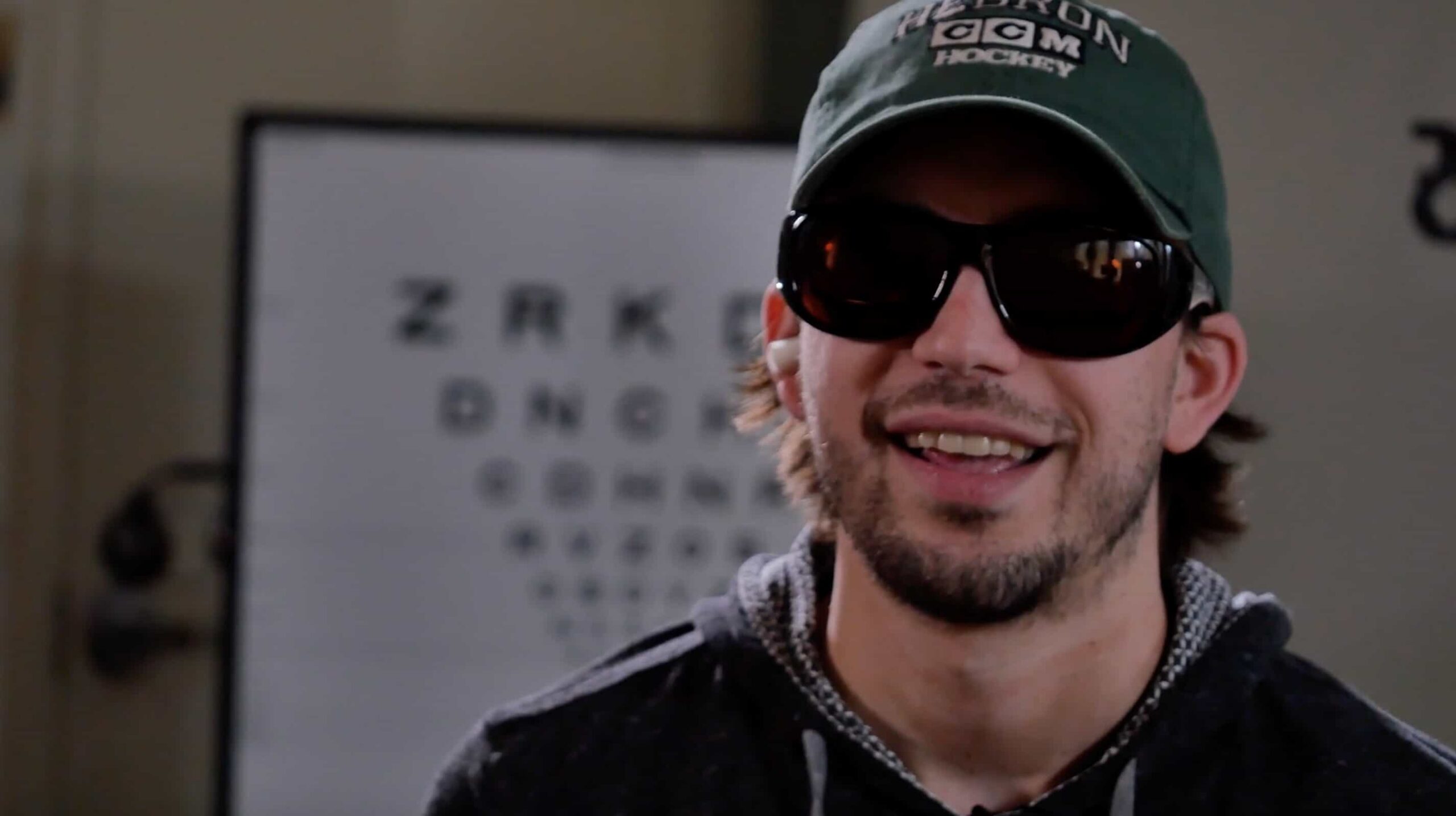A former college hockey player who sustained a series of concussions during play had “lost the feeling of what it is like to be a person,” but now a special pair of eye glasses prescribed by the Mind-Eye Institute “are helping bring that feeling back. When you begin feeling like yourself again, it’s easier to deal with the physical issues.
“The glasses have begun to calm me,” says ex-iceman Damen Fera of Chicago. “It’s as if they have removed a layer of bad from my life.”
But, even more amazing to Damen than the glasses are how Deborah Zelinsky, OD, and her team at the Mind-Eye Institute (https://mindeye.com), based in Northbrook, Ill., are using “different color filters, pieces of tape [placed on lenses] – even bells — to change people’s lives.”
“Part of me can’t believe this stuff works; another part of me asks, ‘Who figured all this out?’ It’s amazing.”
The “bells” to which Damen is referring are used in Dr. Zelinsky’s patented Z-Bell Test℠, a simple but revolutionary method of checking a patient’s overall sense of surrounding space and his or her integration of visual processing with awareness of auditory space.
During the evaluation, a patient reaches out, with eyes closed, and tries touching a ringing bell. If the patient cannot do so, a Mind-Eye optometrist places different lenses, prisms and filters across the patient’s closed eyelids determining an optimal combination to allow the patient to effortlessly find the bell. Light still passes through the eyelids and activates parts of the brain not used for eyesight. With eyes closed, patients are still having to visualize surrounding space in order to locate the bell, explains Dr. Zelinsky, founder and research director of the Mind-Eye Institute.
Damen’s saga began about five years ago when an opposing college hockey player slammed him – and his head — against the rink retaining glass.
“I sustained a concussion at the time – one of several I would later experience during the course of a couple years. However, little did I know that that first concussion would be the real start of my problems,” Damen says.
What he did not realize at the time was that the head injury had disrupted his brain circuitry, making his surrounding world seem confusing.
“When intact, visual processing enables people to understand and respond appropriately to the world around them. The term “processing” refers to the ability of the brain (partially beneath a conscious level of awareness) to take many external sensory signals — from eyesight, hearing, smell, taste, touch; synthesize the information; and react and respond depending on internal sensory signals.
Although he says he did not suffer the kinds of symptoms people typically attribute to a concussion, such as headaches and grogginess, Damen became what he calls “a lot more emotional,” as well as light sensitive, following his injury. “I stopped using overhead lights and only turned on lamps,” he says.
He also struggled with memory loss, developed a debilitating digestive disorder and suffered skin problems.
“I saw every possible health expert – [general] physicians, neurologists, chiropractors, psychotherapists,” Damen says. “Sometimes, what they did worked — until it didn’t work.
“I had gone beyond the ‘end of my rope.’ I felt as though ‘it is what it is.’ I just had to go with it. I couldn’t hope for better.”
But, the “better” happened – in 2016.
He was checking out the postings of a post-concussion group on Facebook when he noticed the image of a page taken from a book, The Ghost in My Brain: How a Concussion Stole My Life and How the New Science of Brain Plasticity Helped Me Get It Back, written by Clark Elliott, Ph.D. and published in 2015. Elliott, a DePaul University Chicago academician and a specialist in applied artificial intelligence, wrote it to detail his eight years of struggles following a mild traumatic brain injury and his search for practitioners who could help him return to his old self. The book describes what he calls the “magic” work of the Mind-Eye Institute. Dr. Elliott worked also with Donalee Markus, Ph.D. from the Highland Park, Ill.-based www.designsforstrongminds.com.
Reading the posting seemed as if “this guy (Elliott) had gone inside my head and written down my thoughts,” Damen recalls. “The book was how I found out about Dr. Zelinsky and the Mind-Eye Institute.”
His first appointment at the Institute was akin to entering a “whole new world,” Damen says. The testing there was “unlike anything that anyone had done before with me – all these different-color glasses, lenses, pieces of tape and bells.”
Damen required a bit of time to become accustomed to his initial pair of therapeutic glasses prescribed him by the Mind-Eye Institute team following extensive evaluation of his condition.
“I developed massive headaches while wearing them but wanted to give them time,” Damen says. “Eventually, the glasses began to calm me; they reduced my anxiety.”
Mind-Eye glasses are not of the ordinary variety simply intended to bring a person’s central eyesight to 20/20 clarity. They are what Mind-Eye professionals refer to as Brainwear™ — therapeutic lenses precisely designed to readjust a patient’s visual processing and eye-ear integration, says Dr. Zelinsky, who performed Damen’s initial evaluation.
“Each pair of eye glasses is individually designed. The glasses give some patients almost immediate relief; others require more time to get accustomed to them,” Dr. Zelinsky adds.
“What the Mind-Eye Institute is doing is truly ground-breaking,” Damen concludes. “This place helps people. It’s helped me. What more can you want?”
Damen no longer plays hockey, but he still enjoys skating. He uses an area rink – “when no one else is there.” Rink staff members are aware of his light sensitivity. “They turn off the lights when I am skating.”

Success Stories, Traumatic Brain Injury
Eye Glasses Are ‘Life-Changing’ for Former Hockey Player
Household Tape, Colored Filters, Bells – Transforming Lives
